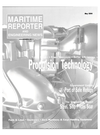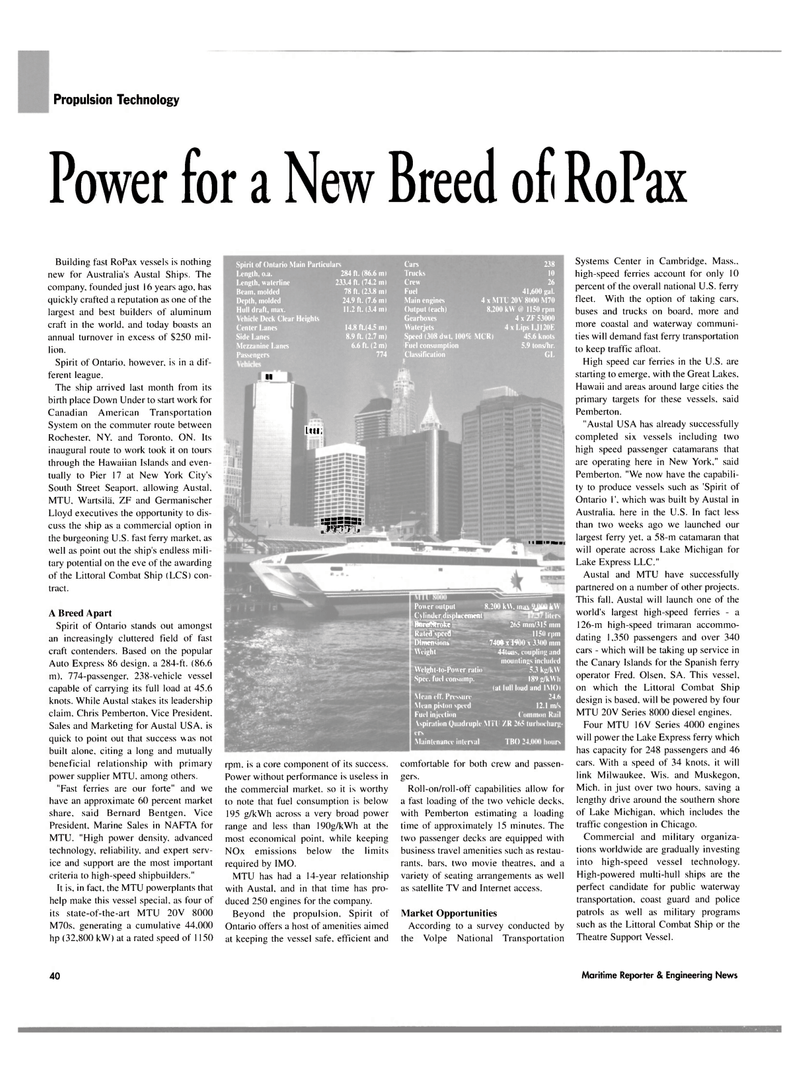
Page 44: of Maritime Reporter Magazine (May 2004)
The Propulsion Technology Yearbook
Read this page in Pdf, Flash or Html5 edition of May 2004 Maritime Reporter Magazine
Propulsion Technology
Power for a New Breed of RoPax
Building fast RoPax vessels is nothing new for Australia's Austal Ships. The company, founded just 16 years ago. has quickly crafted a reputation as one of the largest and best builders of aluminum craft in the world, and today boasts an annual turnover in excess of $250 mil- lion.
Spirit of Ontario, however, is in a dif- ferent league.
The ship arrived last month from its birth place Down Under to start work for
Canadian American Transportation
System on the commuter route between
Rochester. NY. and Toronto, ON. Its inaugural route to work took it on tours through the Hawaiian Islands and even- tually to Pier 17 at New York City's
South Street Seaport, allowing Austal.
MTU, Wartsilii. ZF and Germanischer
Lloyd executives the opportunity to dis- cuss the ship as a commercial option in the burgeoning U.S. fast ferry market, as well as point out the ship's endless mili- tary potential on the eve of the awarding of the Littoral Combat Ship (LCS) con- tract.
A Breed Apart
Spirit of Ontario stands out amongst an increasingly cluttered field of fast craft contenders. Based on the popular
Auto Express 86 design, a 284-ft. (86.6 m). 774-passenger, 238-vehicle vessel capable of carrying its full load at 45.6 knots. While Austal stakes its leadership claim, Chris Pemberton. Vice President,
Sales and Marketing for Austal USA. is quick to point out that success was not built alone, citing a long and mutually beneficial relationship with primary power supplier MTU, among others. "Fast ferries are our forte" and we have an approximate 60 percent market share, said Bernard Bentgen. Vice
President, Marine Sales in NAFTA for
MTU. "High power density, advanced technology, reliability, and expert serv- ice and support are the most important criteria to high-speed shipbuilders."
It is, in fact, the MTU powerplants that help make this vessel special, as four of its state-of-the-art MTU 20V 8000
M70s, generating a cumulative 44.000 hp (32,800 kW) at a rated speed of 1150
Spirit of Ontario Main Particulars Cars 238
Length, o.a. 284 ft. (86.6 ml Trucks 10
Length, waterline 233.4 ft. (74.2 ml Crew 26
Beam, molded 78 ft. (23.8 ml Fuel 41,600 gal.
Depth, molded 24.9 ft. (7.6 ml Main engines 4 x MTU 20V 8000 M70
Hull draft, max. 11.2 ft. (3.4 ml Output (each) 8,200 kW @ 1150 rpm
Vehicle Deck Clear Heights Gearboxes 4 x ZF 53000
Center Lanes 14.8 ft.(4.5 mi Waterjets 4 x Lips LJ120E
Side Lanes 8.9 ft (2.7 m) Speed (308 dwt, 100% MCRl 45.6 knots
Mezzanine Lanes 6.6 ft. (2 m) Fuel consumption 5.9 tons/hr.
Passengers 774 Classification GL
II
Uu: :ss=ss: y IHIS , timimrnmmi
Power output
Cy lintler displacement
Bore/Stroke
Rated speed
Dimensions
Weight
VVelght-to-Power ratio
Spec, fuel consiimp.
Mean ( IT. Pressure
Mean piston speed
Fuel injection
Vspiralion (Quadruple ers
Maintenance interval 8.200 k\\. tn; iiiu'JJMWkW liters 265 mm/315 mm 1150 rpm 7400 x 1900 x 3300 mm 44Uuis, coupling and mountings included 5.3 ks/kVV 189 R/kWh (at lull load and 1MO) 24.6 12.1 m/s
Common Rail
M i l / R 265 turbocharg-
TBO 24,000 hours rpm, is a core component of its success.
Power without performance is useless in the commercial market, so it is worthy to note that fuel consumption is below 195 g/kWh across a very broad power range and less than 190g/kWh at the most economical point, while keeping
NOx emissions below the limits required by IMO.
MTU has had a 14-year relationship with Austal. and in that time has pro- duced 250 engines for the company.
Beyond the propulsion. Spirit of
Ontario offers a host of amenities aimed at keeping the vessel safe, efficient and comfortable for both crew and passen- gers.
Roll-on/roll-off capabilities allow for a fast loading of the two vehicle decks, with Pemberton estimating a loading time of approximately 15 minutes. The two passenger decks are equipped with business travel amenities such as restau- rants. bars, two movie theatres, and a variety of seating arrangements as well as satellite TV and Internet access.
Market Opportunities
According to a survey conducted by the Volpe National Transportation
Systems Center in Cambridge, Mass.. high-speed ferries account for only 10 percent of the overall national U.S. ferry fleet. With the option of taking cars, buses and trucks on board, more and more coastal and waterway communi- ties will demand fast ferry transportation to keep traffic afloat.
High speed car ferries in the U.S. are starting to emerge, with the Great Lakes.
Hawaii and areas around large cities the primary targets for these vessels, said
Pemberton. "Austal USA has already successfully completed six vessels including two high speed passenger catamarans that are operating here in New York," said
Pemberton. "We now have the capabili- ty to produce vessels such as 'Spirit of
Ontario 1'. which was built by Austal in
Australia, here in the U.S. In fact less than two weeks ago we launched our largest ferry yet. a 58-m catamaran that will operate across Lake Michigan for
Lake Express LLC."
Austal and MTU have successfully partnered on a number of other projects.
This fall. Austal will launch one of the world's largest high-speed ferries - a 126-m high-speed trimaran accommo- dating 1,350 passengers and over 340 cars - which will be taking up service in the Canary Islands for the Spanish ferry operator Fred. Olsen. SA. This vessel, on which the Littoral Combat Ship design is based, will be powered by four
MTU 20V Series 8000 diesel engines.
Four MTU 16V Series 4000 engines will power the Lake Express ferry which has capacity for 248 passengers and 46 cars. With a speed of 34 knots, it will link Milwaukee. Wis. and Muskegon,
Mich, in just over two hours, saving a lengthy drive around the southern shore of Lake Michigan, which includes the traffic congestion in Chicago.
Commercial and military organiza- tions worldwide are gradually investing into high-speed vessel technology.
High-powered multi-hull ships are the perfect candidate for public waterway transportation, coast guard and police patrols as well as military programs such as the Littoral Combat Ship or the
Theatre Support Vessel. 40 Maritime Reporter & Engineering News

 43
43

 45
45
